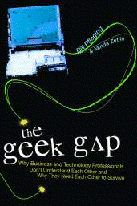Geek Gap Disaster
"Take Off Your Engineer Hat."
The Shuttle Challenger launched on January 28, 1986, after a night when temperatures dipped into the twenties, a most unusual occurrence in Florida. The shuttle's solid rocket boosters, built by Morton Thiokol, were made in segments and sealed together by rubber O-rings. The rings turned brittle in the cold, and the shuttle exploded 73 seconds into its flight. Many factors contributed to this national tragedy, among them the hubris of a space agency that had never seen a shuttle mission fail, and reluctance to cancel the flight for a third time. But the Geek Gap played a part as well.
Late the night before the accident, Thiokol executives and engineers discussed whether to recommend going ahead, as NASA was pressuring them to do. The engineers insisted that launching in cold weather was too great a danger. Ultimately, four Thiokol vice presidents had to decide; three wanted to launch. The holdout was the VP of Engineering. One of the others told him, "Take off your engineering hat and put on your management hat." He relented, and the flight was approved.
Some have since questioned whether this comment was coercion. No one, however, questioned the underlying assumption, so let's question it now: Why would an engineer and a manager, working for the same company on the same project not want the same things? Wouldn't both want the company to be successful? Wouldn't both dread a space flight catastrophe? The assumption that they would not is the essence of the Geek Gap.
The business managers thought the engineers were insisting on absolute certainty--that they couldn't judge what might be an acceptable risk. The engineers did not have the relationship with their bosses that would have led their judgment to be accepted unconditionally. Neither side trusted the other. And this, too, is why Challenger went down.
The Shuttle Challenger launched on January 28, 1986, after a night when temperatures dipped into the twenties, a most unusual occurrence in Florida. The shuttle's solid rocket boosters, built by Morton Thiokol, were made in segments and sealed together by rubber O-rings. The rings turned brittle in the cold, and the shuttle exploded 73 seconds into its flight. Many factors contributed to this national tragedy, among them the hubris of a space agency that had never seen a shuttle mission fail, and reluctance to cancel the flight for a third time. But the Geek Gap played a part as well.
Late the night before the accident, Thiokol executives and engineers discussed whether to recommend going ahead, as NASA was pressuring them to do. The engineers insisted that launching in cold weather was too great a danger. Ultimately, four Thiokol vice presidents had to decide; three wanted to launch. The holdout was the VP of Engineering. One of the others told him, "Take off your engineering hat and put on your management hat." He relented, and the flight was approved.
Some have since questioned whether this comment was coercion. No one, however, questioned the underlying assumption, so let's question it now: Why would an engineer and a manager, working for the same company on the same project not want the same things? Wouldn't both want the company to be successful? Wouldn't both dread a space flight catastrophe? The assumption that they would not is the essence of the Geek Gap.
The business managers thought the engineers were insisting on absolute certainty--that they couldn't judge what might be an acceptable risk. The engineers did not have the relationship with their bosses that would have led their judgment to be accepted unconditionally. Neither side trusted the other. And this, too, is why Challenger went down.



